Proper care, cleaning and maintenance of an inflatable boat will not only keep your boat in tip-top shape, it will also extend its lifespan.
If your boat is cleaned regularly, it will look like new almost all of the time.
But if you don’t clean maintain your boat, the fabric will start turning dark, which will take more effort to clean. It can be done, but it’s better to avoid it with regular cleaning.
Contents
General inflatable boat maintenance and cleaning
It is best to clean and dry your boat properly at the end of each day of use. Leaving the boat uncleaned will cause it to slowly but surely turn gray and spotty. You need to clean it of sand, salt, suncream, etc. at the end of the day, and dry it properly to prevent molding.
Here are the steps to keeping your boat clean during boating season. I have a separate article on preparing your boat for storage.
Rinse after use
Using freshwater from a hose, rinse off the outside and the inside of the boat.
If there are any scuffs, it’s a good idea to deal with them right away. If you don’t have a proper boat cleaning solution on hand, you can use a non-abrasive cleaner such as Jif to do away with these spots.
Also, you want to pay attention to suncream oils. Oils can plasticize the fabric, so it’s a good idea to clean them off.
After you rinse your boat, it should be clean of any sand, dirt, oil or sea salt.
Drying
Rubber is especially prone to developing mildew if left wet. Mold is very tricky to deal with once it develops (more on that later), so it’s best to prevent it.
At the end of this article, I will write about how to dry your boat before storage to prevent mildew, but if you are on holiday and will not deflate your DIB, that is overkill.
You can take these simple steps to dry it after rinsing.
- Turn it over and let the water drain out.
- Grab a towel and wipe your boat dry.
- Get another towel and soak up the water in between the floor and the side tubes, where water gets caught. Mold can easily grow in these sneaky areas.
If you’re lucky and it’s a sunny day, the sun will help you dry your boat. Just remember not to leave the boat out in the sun for too long, and to still
303 UV protection every other month
You already know that you shouldn’t leave your boat out in the sun for extended periods. It is also a good idea to apply a UV protectant spray every once in a while to prolong the life of the boat fabric.
I recommend 303 UV Protectant for this. It is great at preventing UV degradation, which is basically your boat’s worse enemy.
Besides protecting the rubber from UV rays, I’ve found it brightens my boats as well. It is non-greasy and doesn’t need to be rinsed off. Just spray it on, and it goes to work.
Looking at the Amazon page for it, it has a 4.6-star review out of 5, so others are satisfied with it as well.
Just remember that if you have a PVC boat, you should only use 303 twice per year. This is because PVC contains plasticizers, which 303 UV protectant can bleed out if used too often. The pros still recommend 303, just not the overuse of it.
Cleaning tougher stains
If your boat is sticky or has severe discoloration, don’t worry. It will take a bit of work, but even the dirtiest boats can be brought back to almost new condition.
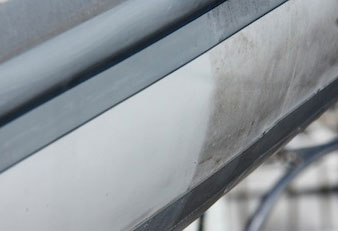
The things you’ll need:
- An inflatable boat cleaning solution from the list below
- A few large sponges, Scotch-Brite pads or large brushes
- Latex gloves to protect your hands from the chemicals
- Water to rinse off, preferably strong hose sprayer
- 303 UV protectant to finish off
These are the steps you take to clean dirty boats:
- You’ll be cleaning small areas of the boat at a time.
- Spray some water on the area, it helps disperse and thin out the cleaning solution.
- Now spray the cleaner onto the same area and let it sit for about a minute.
- Scrub the given area with a sponge or rag until the stains come off and the boat starts looking like new. Clean your rag/sponge every so often, as it can become very dirty.
- Repeat for the entire boat.
- Coat the boat with 303 Protectant at the end to prevent mildew and UV damage.
I’m not going to lie, this takes a lot of elbow grease. You will get sore muscles and a sore back by the end, but your boat will look like new.
TIP: If your boat is very dirty, use this soft drill brush to make the work a lot easier. Attach it to a drill, and it’ll scrub away the dirt.
You can expect very good results even from the dirtiest boats.
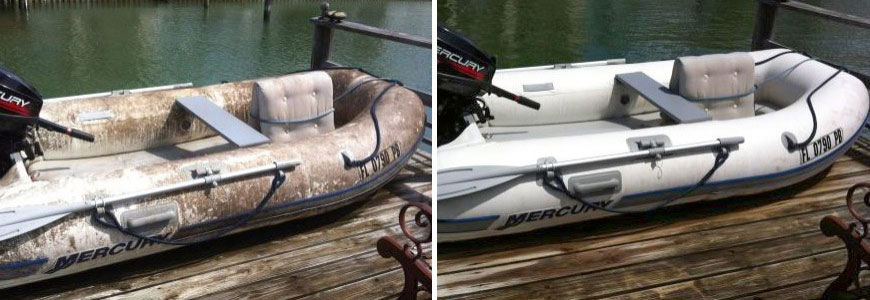
Inflatable boat general cleaning products
I have tried many SIB cleaning products over the years. You can use any of these for PVC and Hypalon.
Here how to use inflatable boat cleaners:
- Wet your boat
- Spray the cleaner everywhere
- Let it sit for a minute
- Scrub-a-dub-dub (tiring by the end)
- Rinse off and presto, you have a clean boat
Here are the best general cleaners:
Star Brite
This cleaner does a great job at cleaning PVC and Hypalon, it also has a UV protectant mixed into the solution.
This is my cleaner of preference, although it’s on the expensive cleaners list. It has received many good reviews and feedback on Amazon as well.
It’s very easy to use and can achieve miracles on boats you wouldn’t think can look normal again.
NRS cleaner
This is one of the best cleaners against general dirt, but I’ve found it not effective against mold spots.
It is priced well, so that’s also a plus.
If you are looking for a general cleaner, give this one a try.
MDR Cleaner
This is another good one, it’s a bit cheaper than NRS as well. It cleans dirt, oil and grime away nicely, but it’s not so good against mildew.
Usage is the same as the NRS solution, so it’s fairly simple to use.
MDR Cleaner is biodegradable, so it doesn’t contain any harmful chemicals or silicone.
Mary Kate cleaner
This is another biodegradable cleaner that does not have any silicone in it, so it’s not so bad for the environment.
I have mixed feelings about this one. I had a bottle a while back, and at times it worked well, but other times I felt it could have done a better job.
It’s priced below Star Brite, so you can give it a try on your boat if you want to save a few dollars.
Seapower Marine cleaner
This is a good pruduct, it cleans dirt, grime and oxidation well.
The only thing I don’t like about it is that it is not a spray like the other cleaners. The Seapower Marine cleaner needs to be applied to a cloth or towel, and rubbed against the boat’s fabric.
It gets the job done, but it’s a bit more work than the others.
West marine inflatable boat cleaner
West Marine developed its own cleaner.
It is priced well, but I found it isn’t as effective as Star Brite. Don’t really have anything else to say about it.
Homemade inflatable boat cleaning solution
If you want to save a few dollars or don’t have a professional cleaning solution with you, you can make your own homemade inflatable boat cleaner. This will not be as effective as the specially formulated cleaning agents above, but will work on lighter stains and dirt patches.
Here is the recipe to my homemade boat cleaner, very simple.:
- Use any household non-abrasive cleaning product
- Mix it with water
- Add a bit of vinegar
Keep in mind though that tough stains will not come off with soapy water, and non-abrasive cleaners like Jif and Cillit Bang are better at clearing dirtier areas.
Someone asked me about Mr Clean’s Magic Eraser. I would not use it on inflatable boat materials, as it is abrasive.
What NOT to use for cleaning your boat
There are a few products you should never use for cleaning your boats. They will cause damage to the material, and significantly shorten the lifespan of your boat by weakening and discoloring the fabric, and even attacking the adhesives.
These products are:
- MEK
- solvents
- toluene
- acetone
- bleach
- ammonia
- highly alkaline cleaners
- abrasive scrub pads
- steel wool
Just say no to the above, and you should be fine.
Cleaning mold (mildew) off a SIB
Picture this, it happened to me 3 years ago.
My Mariner 4 was in storage for a long while, and I finally decided to take it out and use it.
But OMG. My once beautiful raft had succumbed to green and black mold. Yuck!
I quickly asked around to find out how to clean mold off an inflatable raft. It turns out mold cannot be cleaned off with a regular cleaning product, you need a specialized one.
The product I used was the Starbrite Mold & Mildew Stain Remover.
It worked wonders, and it was straightforward to use. All you need to do to remove mold with this product is wipe or spray it on the mold, and wait.
It basically dissolves mildew on contact: you can see it working as the black-green spots start disappearing. It takes a while, but it works.
It was pretty cool!
It contains hypochlorite and hydroxide, so if you have a colored boat, I would color test it first to make sure it doesn’t have any adverse effects.
Green tip: If you like using natural and organic materials instead of cleaning products like the ones listed above, you may try to use white vinegar. Vinegar has a slightly acidic solution that can kill mold without damaging the fabric of your inflatable.
Preventing mold is better than treating it
Although there are ways to rid your inflatable boat of mold, sometimes the mold reaches far into the material and continues to thrive within the boat.
This will mean that the molding issue will be persistent and return with time.
As always, prevention is better than a cure.
Here are the best ways you can keep your dinghy dry and prevent mold from forming.
Dry your inflatable boat properly
Mold forms in humid environments and unventilated areas.
To prevent mold from forming, dry your boat properly after use or washing. Below is a step-by-step guide on how to dry your inflatable dinghy.
- Remove seats, bags, and other items from your dinghy.
- Use a towel to dry the outer part of your inflatable boat.
- Deflate the floor, and then tilt the boat sideways or upside down to drain excess water from the boat.
- Wipe away the remaining water in the boat.
- Use the towel to clean any debris, sand, or gravel in the boat.
- Deflate the rest of the boat.
- Use a different towel to continue drying up the boat.
- Check if there are still damp areas.
- Roll it, and wipe as you roll. Fold and pack it away.
Tip: When drying an inflatable boat, always prepare more than 2 dry towels.
Feeling lazy? If it’s sunny out, you can leave your inflatable boat out to dry under the sun for a short period of time. This isn’t recommended though, for it may cause the fabric of your inflatable boat to fade faster and deteriorate.
Correct way of storing your SIB to prevent mold formation
To fold it:
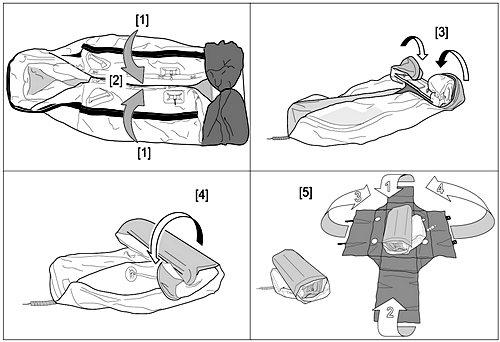
- Fold the pontoons in, and make sure they are not wider than the transom.
- Make it flat.
- Next, fold the cones in.
- Roll up the boat, beginning from the transom. Fold the nose and finish rolling the boat.
- Place folded boat and accessories on the carry bag. Fold the flaps, and then store it away – preferably somewhere not so humid.
Avoid: Do not store your inflatable boat in a humid environment. Do not, under any circumstance, roll and fold a not-so-dry inflatable boat, more so store it away.
If you’re storing it for a long period of time, you can pack your dinghy up with moisture absorbers like DampRid. You can buy it on Amazon, it’s very cheap and should always be used when storing a deflated rubber boat.
Other options are putting silica gel or homemade desiccants to keep it dry. Use these especially if you are going to store your dinghy in a humid environment or during the winter season.
Cleaning Hypalon boats vs PVC boats
A common question I get is whether you can use the same cleaning solvents on PVC boats and Hypalon boats.
The answer is yes.
You can clean Hypalon boats and PVC boats with the same specialized products.
Just remember that the products used on inflatable boats are different than those used on traditional fiberglass boats. Those are not to be used.
Should you clean a brand new boat before use?
When you get a new boat, the last thing you think about is cleaning it before use.
But yes, you really should clean it before use.
Why?
Fabric manufacturers don’t always clean their fabric of lubricants used during manufacturing, and the actual boat manufacturer might not clean it either. If there is lubricant residue left on the material, it might react with the sun and water, causing discoloration, mildew, waterline stains or even marine growth on the bottom of the boat.
So yes, just to be safe, you should clean your boat before your first use.
You will need a specialized product to strip away the lubricants used in manufacturing though. Speed Clean is a good one for this. It’s not a good general cleaner (even though their ads say it), but it is good at removing pollutants and lubricants.

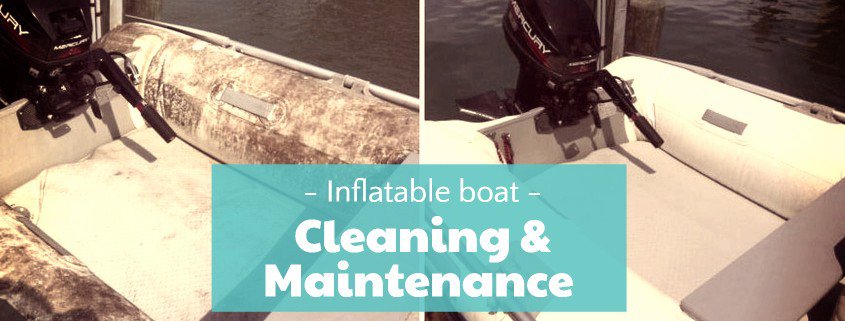
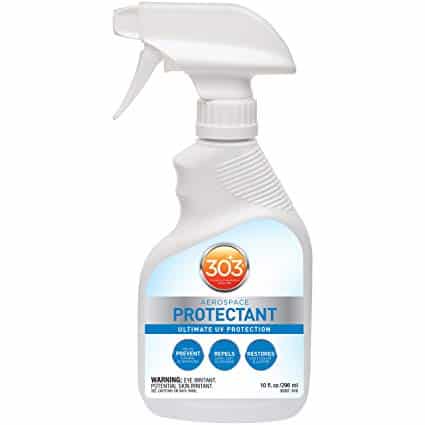
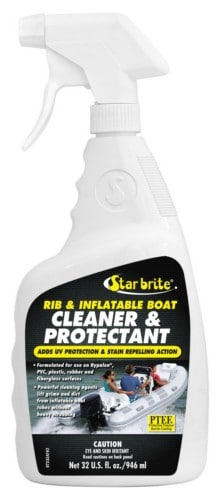
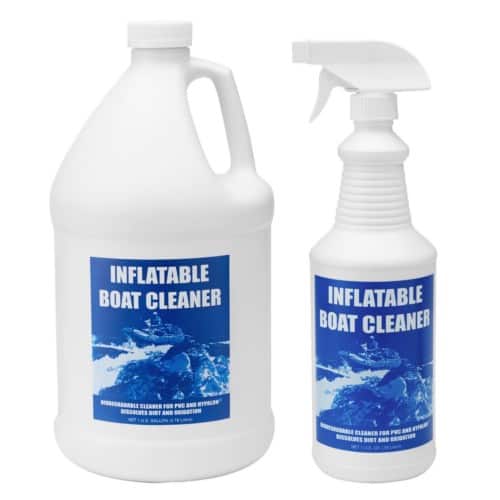
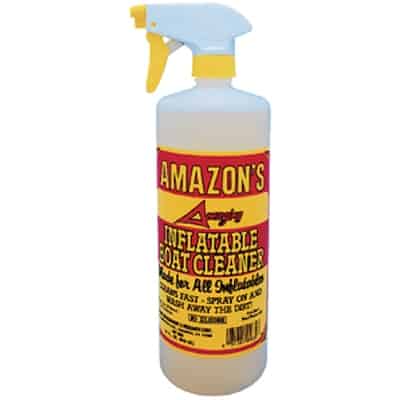
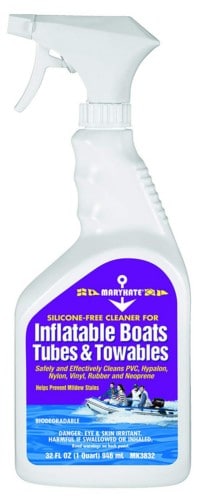
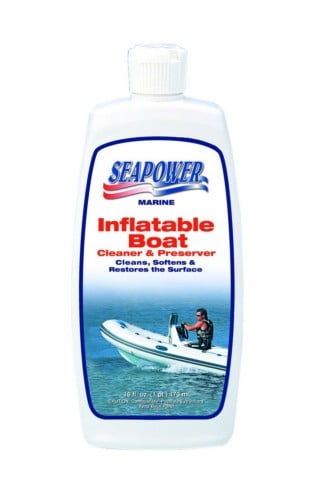
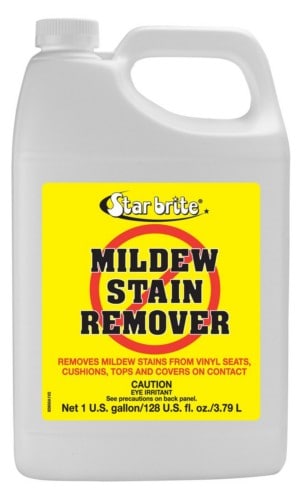



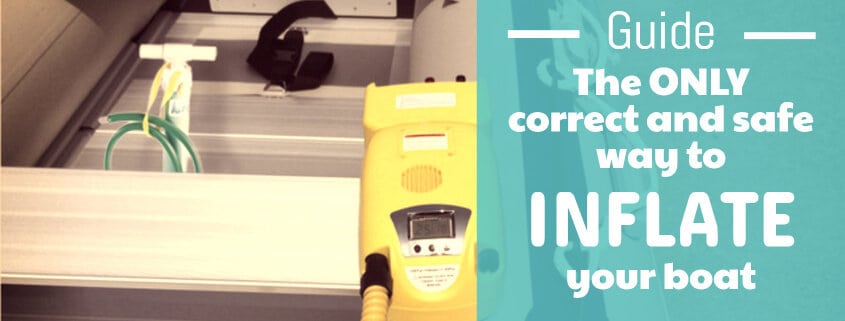
We have an inflatable PVC dinghy that stores hull up on the bow of our sailboat in the summer.
We didn’t cover it the last summer and the hull surface is now a sticky mess. The pontoons are fine. Is there anyway to get that stuff off. Anything it touches it leaves behind a mark and yuck–including on ones hands. If it can’t come off can it be painted over?
Yes, clean it as per the instructions in the article first. You probably won’t need to paint it once the gunk comes off. But you can if you want to, just use the appropriate paint.
What are the ingredients to look for that’s harmful to the boats?
If you go back to the article, there is a section that talks about this:
What NOT to use for cleaning your boat
Hey Tom,
I have a 40+ year old French made zodiac zed38 I got from my grandpa. It spent its first 5 or 6 years in Alaska followed by around 30 years stored in a barn in idaho. I’ve had it for the last 5 or so. Everyone says that pvc boats don’t last longer than 10 or 15 years. So how has mine lasted as long as it has? Were zodiacs made better in 1981? Shouldn’t the glue, if nothing else, have given up the ghost by now? Am I at risk of the boat coming apart while I’m scooting across the water at 20 mph?
-Aaron
Hi Aaron, wow, I’ve not heard of a PVC boat last that long. I can’t really advise on it without seeing it, you should probably take it to a specialist nearby to have it checked out.
Very instructive post about how to take care of our inflatables, thanks a lot for it!
Tom: I have a PVC Zodiac Yachtline that I installed new tubes on 5 years ago. Did not use my Zod last year at all and it sat on my boat for the year with a Sunbrella black custom cover. I am refurbishing and new power but purple black spots on the tubes appear impossible to remove with Starbrite as you recommend or any number of things. Any suggestions?
Hi Carson, the Starbrite mildew cleaner should take care of mold. It worked wonders for me, and you can see many before-after pictures of people posting their reviews to Amazon.
Maybe the spots are not mold?
Hi Tom
What are your thoughts on the use of Simple Green? I have been using it for a few years and see no issues so for. I use this in conjunction with water, scrub brush, sponge with green scrubby on the other side .
Then I 303 after it dries.
Hi Dave, I’ve never used it, but looking at the ingredients, it doesn’t have anything that could harm an inflatable boat.